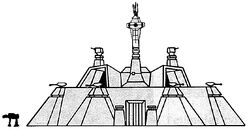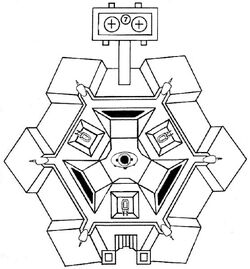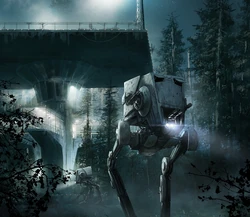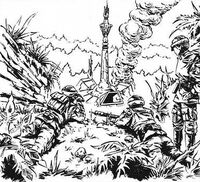Their pacification is your security.Rothana Engineering motto for the IM-455 modular garrison
The IM-455 modular garrison, also known as The Peacekeeper,[1] was the Empire's standard base deployed on planets to keep the peace and serve as a home for its troops.[2] It was built by Rothana Heavy Engineering as a rewarded manufacturing contract, and its main purpose was to allow an Imperial Army commander to achieve the same results of turning a venerated political/religious structure into the seat of power for the Empire on a world and at the same time allow for optimized defense. A standard Imperial garrison was elevated for observation and angled for defense, and acted as a symbol to rebellious populations that the Empire wasn't going anywhere.[1]
Characteristics
Greetings! As the commander of an IM-455 modular garrison you are in possession of an impregnable fortress that stands as a symbol of Imperial power.Rothana's official statement about the garrison

Garrison bases consisted of eight levels, topped by a sensor and communications tower. Levels one through to five, all identical in size and shape, consisted mainly of the large surface vehicle bays where all the surface vehicles were stored, maintained and deployed from.[2] The vehicle bays were large enough to accommodate AT-ATs.[1] They also contained most of the personnel quarters as well as the armory, detention cells and most other key base areas.[2] It also contained a recreation center, which by 0 BBY added a scoopball court by popular request.[1]
Level six held the officers' quarters, TIE fighter pilots' quarters, command rooms and so on. Level seven consisted entirely of the TIE/LN starfighter hangars. Level eight was the deployment chutes and control rooms for the base's TIEs. TIEs were launched, retrieved and manipulated by the base's powerful suite of tractor-beam projectors. Garrison bases also had underground sub-levels which contained the generators (including the main reactor[1]) and main infrastructure.[2] The roof contained the sensor suite tower, which was equipped with a hypercom array as well as Rothana's patented mix of thermo-infra-ecto multivariate sensors.[1]
Models
Although the basic garrison was a standardized model, several variations existed:
Shield projector garrisons
The shield projector garrison was a model that was utilized for Imperial orbital construction projects, where it projected an uninterrupted energy shield around the orbital site. It had enough defenses to put down planetside uprisings from the conscripted workforce. It includes a command garrison, which was broken down into several smaller structures similar to the IM-445, albeit with an armored bunker to house the generator; a 20-meter-tall landing pad to accommodate docking AT-ATs as well as two to three Lambda-class shuttles; and the SLD-26 planetary shield generator.
Oceanic garrisons
An aquatic model, the oceanic garrison, lacked the underground levels and had several powerful repulsorlifts to keep it afloat. In addition, it was equipped with underwater hangar bays. The contingent included seatroopers and AT-AT swimmers.[3]
Orbiting garrisons
An orbiting garrison was two standard garrisons locked together base-to-base, but this variation was rarely deployed. These garrisons were only deployed in orbits around extremely hostile and dangerous planets. This provided the troops on the ground with an orbital fire base and also made the headquarters extra secure. Orbiting Garrisons could support a full TIE wing and several orbital tugships. Since the garrisons lacked engines, the tugs were the only means of propulsion.[3]
However, orbiting garrisons created a controversy with the Navy, which considered all space-deployed units their jurisdiction. In the end, the command on orbiting garrisons was split between Navy and Army, with one base commanded by an Admiral, the other one by a Major General. Additionally, a new orbital defense platform for the Navy was put into production.[3]
Hostile-environment garrisons
For planets with unfriendly climate, the hostile-environment garrison was equipped with sealed airlocks on all entry points on an extra life-support sub-level.[3]
Garrison complexes
Several standard garrisons could be deployed in proximity to form a garrison complex. The buildings would be connected via underground tunnels and walkways. The largest complexes were constructed of up to six garrisons arranged in a ring. Like orbiting garrisons, these complexes were rarely constructed. Only worlds of major strategic importance required such a great headquarters. Most complexes were headquarters of an Army, a Systems Army, or a Sector Army and commanded by a General.[3]
Personnel

Imperial garrisons were commanded by a Major General and housed 3000 base personnel divided as follows:
- 300 command personnel[2]
- 500 support/services personnel[2]
- 200 technical personnel[2]
- 200 science personnel[2]
- 100 medical personnel[2]
- 100 gunners/weapons technicians[2]
- 80 walker technicians[2]
- 70 trade mission/diplomatic personnel[2]
- 60 ground crew technicians[2]
- 25 controllers[2]
- 25 sensor technicians[2]
- 10 speeder bike technicians[2]
- 50 Imperial Intelligence officers[2]
The numbers of specific staff were flexible to the mission's needs.
Documents produced by the opposing Rebel Alliance stated that Imperial garrisons were typically organized around a Corps HQ detachment from the Imperial Army. Rather than a team of 50 Imperial Intelligence officers, there were in fact 50 Imperial Security Bureau agents, and only a single Imperial Intelligence liaison, known as the "Ubiqtorate Man".[4] [3]
An introductory briefing on Imperial garrisons for Alliance personnel, authored by Major Viran Qol, also stated the vehicle-maintenance organization differently - rather than a dedicated maintenance element of 80 technicians for the AT-ATs and AT-STs, there were just seventy personnel attached to these vehicles including their combat crews, implying just twenty support personnel; however, they were assisted as required by an additional garrison motor pool whose primary role was the maintenance of the base's other vehicles.[3]
The ground crew, controllers and sensor techs were part of the attached TIE Fighter wing.[4] Major Qol's briefing states that this unit was seconded from the Navy, but lists the sensor techs as belonging to the garrison's Army maintenance detail.[3]
Beyond these support personnel, the actual military component was comparatively small.[3] A standard Corps HQ had a core of 403 officers and men, plus a 144-man support unit from CompForce.[4] But the CompForce detachment was not present in all garrison commands.[3] The additional garrison personnel comprised civilian political, economic and science missions, though as supernumeraries in a military base, they were all required to have basic firearms training.[4][3]
On planets with multiple garrisons, only the primary base had a full Corps HQ deployed, and the others, known as "sub-garrisons", were manned by smaller Battlegroup HQs and lacked the civilian personnell and air wing.[3]
The standard garrison also had the Corps HQ allocation of 2,000 droids, including massive I2F-series automated manufacturing units, which made them largely self-sufficient in materiel. Many of the base's other droids were assigned to support the I2Fs, including many MSE-6s, but there were also others, such as servant and security units, which performed more general duties around the base. Astromechs, protocol, and labour units could also be found in various roles.[3]
Combat forces
- 50 walker crews[2]
- 40 TIE fighter pilots[2]
- 800 stormtroopers[2]
- 200 perimeter support troops[2]
- 150 base security/detention troops[2]
- 40 scout troopers[2]

The 800-man stormtrooper unit was the largest component of the garrison.[2] The Alliance briefing cited above stated that it was constituted as a battalion, with the scout troopers as a separate platoon. The garrison's AT-ATs and AT-STs were also attached to the stormtrooper component, although their crews and support personnel were not themselves stormtroopers, but experienced Army personnell.[3]
The TIE Pilots, in contrast, were Navy personnel serving under Army command.[3]
The other troops were part of a straightforward Army hierarchy. In keeping with the Corps HQ structure, the perimiter troops comprised six platoons, with a theoretical strength of 228 men (192 troopers, 30 NCOs and 6 officers); they were equipped with specially-trained guard animals such as Garrals, and were placed directly under the major-general or else his second-in-command, a high colonel who doubled as the base's military intelligence officer. Simultaneously, the security detail was structured as a line company, with a combat strength of 152 men (128 troopers, 20 NCOs and 4 subalterns), and commanded by the "headquarters officer", another high colonel who was in charge of base adminstration and security. Three more officers of this relatively high rank headed the garrison's non-combat elements, and each of the five had two lieutenant colonels to assist them. These fifteen colonels also formed the senior personnel of the 403-man Corps HQ.[3]
Although in practice a garrison's fighting strength often mustered only a handful of companies, each base was in principle supposed to be assigned an additional force of four battalions of Imperial Army soldiers beyond its HQ detail and stormtroopers, and had barracks accommodation available for these personnel.[4][3] One Alliance document stated that the force deployed often comprised the stormtrooper battalion, plus two battalions of AT-ATs and one of AT-STs,[4] but Major Qol stated that this was an error, as the AT-AT and AT-ST numbers a base could accommodate were well below battalion strength.[3]
Some garrisons acted as command bases for much larger formations, in some cases as many as sixty-two battalions organized into four battlegroups. These were much too large to house inside the base itself, and required separate barracks complexes.[3]
The standard four-battalion deployment was the equivalent of a regiment and the largest multi-battlegroup commands were the equivalent of a full corps, but the forces involved were not normally constituted as unified formations at the level suggested by their total strength, as they were created by combining various smaller units, and lacked the appropriate high-level command elements, being obverseen instead by the garrison's own HQ detail. In practice, garrison assignments were often used as convenient places to base detached Imperial Army units which had become dislocated from larger formations.[3]
Sometimes, however, garrisons had COMPForce Assault paramilitaries deployed at regimental strength in place of Army units, paricularly for occupation duty.[3]
Secondary sub-garrisons within larger occupation commands could oversee troops up to battlegroup strength, and were particularly prone to having CompForce Assault units deployed in place of regular Imperial Army formations.[3]
Vehicle complement
- 30 TIE/LN starfighters and 5 TIE bombers[2]/36-40 TIE fighters (three squadrons)[1]/24 standard TIE Fighters, 4 TIE/rc starfighters and 12 TIE/gt starfighters.[3]
- 10 AT-ATs[2][1]
- 10 AT-STs[2][1]
- 40 speeder bikes and 60 other repulsor vehicles such as XP-38s[2]/40 speeder bikes for biker scouts and 60 other combat and support vehicles, including some additional speeder bikes for other personnel[3]/50-100 speeder bikes and/or landspeeders[1]
- 100 miscellaneous vehicles (cargo load-lifters, construction vehicles, etc.)[2]
As noted above, Alliance material stated that the garrison's AT-ATs and AT-STs, although crewed by the Army, were attached to the Stormtrooper battalion, as were forty speeder bikes for the scout troopers. The breifing source stated that the other sixty vehicles under direct Army command typically included other non-combat speeder bikes and speeders, and an armoured repulsor limousine for the commanding general, but also an inventory of combat vehicles - a PX-4 Mobile Command Base, five LAVr QH-7 Chariots, and additional troop transports, often including at least one wheeled juggernaut, and in bases with responsibility for urban areas of any size, usually a single Floating Fortress. Where multiple garrisons were deployed as part of the same occupation force, the secondary bases were often able to obtain multiple Floating Fortresses to compensate for their otherwise reduced manpower.[3]
The TIEs were provided by the Navy.[3] Variations in the size of the air wing reflect the fact that a TIE Bomber required the equivalent of two fighter slots in the launch rack.[2]
Defenses
Garrison bases were equipped with three heavy twin turbolaser turrets and six heavy laser turrets, as well as tractor beam projectors.[2]
The garrison was protected by ramparts up to 10 meters thick, and had powerful deflectors.[2] In addition to being armoured and shielded, garrisons also possessed extensive external ground defenses. Firstly, the base was surrounded by a flat, open area, where attackers would be completely exposed to weapons fire from the inner defences of the base itself.[3] This area was also guarded by anti-infantry and anti-vehicle minefields, specialised probe droids, and a unit of AT-STs.[2][3]
The exterior perimiter was formed by a ten-meter high electrified death fence.[2] This was powerful enough to kill a sentient in an instant, or disable a repulsorcraft.[3] Lower power settings could also be used, depending on the base commander's choice, where it it could simply shock an individual.
Running just behind the fence was an elevated patrol catwalk with guard towers spaced every 100 meters, each equipped with electrobinoculars, floodlights, and alarm systems. To get through the fence and into the base, units had to pass through a limited number of force field gates, each flanked by an additional pair of guard towers. These gates were usually between two and four in number, positioned evenly around the fence's perimeter.[2]
The catwalk patrols consisted of stormtroopers, who also controlled the voltage in the "death fence", whereas the access gates were guarded by Army perimiter platoons, who also provided additional ground patrols directly behind the fence.[3]
Some garrison bases were positioned to use the terrain to their advantage, such as setting them into mountainsides or on outcroppings. These tailored their ground defenses accordingly. Garrison bases also possessed air recyclers and advanced environment and filter systems allowing them to be deployed almost anywhere, from hostile worlds to asteroids.[2]
History

Boba Fett once took an assignment to capture a criminal, conveniently the brother of a base commander, on the order of Jabba the Hutt. His actions to capture the criminal forced him to destroy most of the base, including two AT-ATs, two AT-STs, and the commanding general. The engagement gave the criminal time to escape.[5] As a result of this, although the Imperials denied the rumors of Boba Fett breaching the garrison, they nonetheless developed and distributed a defensive upgrade called XZD-001: FETT COUNTERMEASURES as a result.[1]
Star Destroyers like the Imperial-class could carry one of these installations, while an Executor-class Star Dreadnought could carry up to three.[2] Prefabricated bases were dropped from orbit in ready-made pieces and assembled on-site by Imperial engineers and construction droids. The Y-85 Titan dropship was essential to this purpose onboard Imperial ships larger than Star Destroyers.[6]
Han Solo claimed that he and Chewbacca infiltrated the garrisons more than once, and even offered to aid fellow New Republic general Crix Madine in training various troops on how to do so. Madine, however, was skeptical of this claim, even telling Solo that he would have borrowed a holothriller if he wanted fiction in response.[1]
Appearances
- The Abduction (also reprinted in Classic Adventures)
-
 "Festival of High Winds" — Star Wars Adventure Journal 12 (Indirect mention only)
"Festival of High Winds" — Star Wars Adventure Journal 12 (Indirect mention only) - Star Wars: Force Commander
-
 "Changing the Odds: The Adventures of Dannen Lifehold" — Star Wars Adventure Journal 3 (also reprinted in Hyperspace: The Official Star Wars Fan Club) (Mentioned only)
"Changing the Odds: The Adventures of Dannen Lifehold" — Star Wars Adventure Journal 3 (also reprinted in Hyperspace: The Official Star Wars Fan Club) (Mentioned only) -
 "Lens Reekeene Is Missing" — Star Wars Campaign Pack (also reprinted in Classic Campaigns)
"Lens Reekeene Is Missing" — Star Wars Campaign Pack (also reprinted in Classic Campaigns) - The Truce at Bakura
-
 "Mission to Zila" — Star Wars Adventure Journal 3 (also reprinted in Hyperspace: The Official Star Wars Fan Club)
"Mission to Zila" — Star Wars Adventure Journal 3 (also reprinted in Hyperspace: The Official Star Wars Fan Club) - Heir to the Empire (and unabridged audiobook)
- Dark Force Rising (and unabridged audiobook)
- The Last Command (and unabridged audiobook)
-
 "No Disintegrations, Please" — Star Wars Adventure Journal 14 (In flashback(s))
"No Disintegrations, Please" — Star Wars Adventure Journal 14 (In flashback(s)) -
 "Two for One" — Star Wars Adventure Journal 15 (as prefabricated garrison) (Mentioned only)
"Two for One" — Star Wars Adventure Journal 15 (as prefabricated garrison) (Mentioned only)
Sources
- ° Star Wars Weekly 60 (First appearance)
- The Star Wars Sourcebook
- The Rebel Alliance Sourcebook (Picture only)
- Cracken's Rebel Field Guide (as Imperial Garrison base)
- Wanted by Cracken (as pre-fabricated garrison)
- The Rebel Alliance Sourcebook, Second Edition (Picture only)
- The Star Wars Sourcebook, Second Edition
-
 "Blasters for Hire" — Star Wars Adventure Journal 3
"Blasters for Hire" — Star Wars Adventure Journal 3 -
 "Smuggler's Log" — Star Wars Adventure Journal 7
"Smuggler's Log" — Star Wars Adventure Journal 7 - The Essential Guide to Vehicles and Vessels
- Shadows of the Empire Planets Guide
-
 "Imperial Garrisons" — Star Wars Adventure Journal 12
"Imperial Garrisons" — Star Wars Adventure Journal 12 - Wretched Hives of Scum & Villainy (as prefab garrison)
- Star Wars Trilogy Sourcebook, Special Edition (as prefab garrison)
- Star Wars Encyclopedia
- Hideouts & Strongholds
- The Official Star Wars Fact File 11 (STA 3-4: Imperial Star Destroyer)
- The Official Star Wars Fact File 123 (GAR 1-2: Imperial Garrison Base)
- Inside the Worlds of Star Wars Trilogy
- Star Wars: Complete Locations
- Star Wars: Imperial Handbook: A Commander's Guide (First identified as IM-455 modular garrison)
Notes and references
- ↑ 1.00 1.01 1.02 1.03 1.04 1.05 1.06 1.07 1.08 1.09 1.10 1.11 1.12 1.13 Star Wars: Imperial Handbook: A Commander's Guide
- ↑ 2.00 2.01 2.02 2.03 2.04 2.05 2.06 2.07 2.08 2.09 2.10 2.11 2.12 2.13 2.14 2.15 2.16 2.17 2.18 2.19 2.20 2.21 2.22 2.23 2.24 2.25 2.26 2.27 2.28 2.29 2.30 2.31 2.32 2.33 2.34 2.35 2.36 The Star Wars Sourcebook
- ↑ 3.00 3.01 3.02 3.03 3.04 3.05 3.06 3.07 3.08 3.09 3.10 3.11 3.12 3.13 3.14 3.15 3.16 3.17 3.18 3.19 3.20 3.21 3.22 3.23 3.24 3.25 3.26 3.27 3.28 3.29
 "Imperial Garrisons" — Star Wars Adventure Journal 12
"Imperial Garrisons" — Star Wars Adventure Journal 12
- ↑ 4.0 4.1 4.2 4.3 4.4 4.5 Imperial Sourcebook
- ↑
 "No Disintegrations, Please" — Star Wars Adventure Journal 14
"No Disintegrations, Please" — Star Wars Adventure Journal 14
- ↑ Inside the Worlds of Star Wars Trilogy
